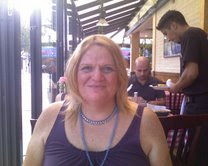Today is Transgender Day of Remembrance.
This day was first observed in 1999, one year after Rita Hester was murdered in her Allston, Massachusetts apartment. She was killed just two days before she would have turned 35 years old.
Her death came just a few weeks after Matthew Shepard was beaten and left to die on a cold night in the Wyoming high desert. Their deaths helped to bring about the hate-crime laws now on the books in the US as well as many state and local statutes. Moreover, Hester's killing--while not as widely publicized as Shepard's--galvanized transgender activists all over the world.
Because I am--at least to my knowledge--the only transsexual woman with a bike blog, I am going to use this post to honor one of the greatest transgender athletes of our era.
Michelle Dumaresq was born in 1970. In 2001, she entered and won her first competitive mountain biking event--the Bear Mountain Race in British Columbia, Canada. After she won two more races, her racing license was suspended in response to complaints from other female riders. The cycling associations of British Columbia and Canada, after meeting privately with race organizers, tried to pressure her into quitting. Of course, she wouldn't, and after a meeting with UCI officials, it was decided that she could continue to compete as a female.
Other female riders felt she had an unfair advantage. Their resentment was, not surprisingly, based on a common misunderstanding. Dumaresq had her gender reassignment surgery in 1996, five years before her first victory, and had been taking female hormones--and a male hormone blocker--for several years before that. By the time she started racing, she no longer had any testosterone in her body (Biological females have traces of it.) and she had lost most of the muscle mass she had as a man.
I know exactly where she's been, as I also had the surgery after six years of taking hormones and a testosterone blocker. A few months into my regimen, I started to notice a loss of overall strength, and I noticed some more after my surgery. Trust me, Ms. Dumaresq, as talented and dedicated as she is, had no physiological advantage over her female competitors.
I remind myself of that whenever another female rider (usually, one younger than I am) passes me during my ride to work!
But I digress. Michelle Dumaresq had the sort of career that would do any cyclist--male or female, trans or cisgender, or gay--proud. She won the Canadian National Championships four times and represented her country in the World Championships. That, of course, made the haters turn up the heat. When she won the 2006 Canadian National Championships, the boyfriend of second-place finisher Danika Schroeter jumped onto the podium and helped her put on a T-shirt that read "100% Pure Woman Champ."
Ms. Dumaresq would have looked just fine in it.
This day was first observed in 1999, one year after Rita Hester was murdered in her Allston, Massachusetts apartment. She was killed just two days before she would have turned 35 years old.
Her death came just a few weeks after Matthew Shepard was beaten and left to die on a cold night in the Wyoming high desert. Their deaths helped to bring about the hate-crime laws now on the books in the US as well as many state and local statutes. Moreover, Hester's killing--while not as widely publicized as Shepard's--galvanized transgender activists all over the world.
Because I am--at least to my knowledge--the only transsexual woman with a bike blog, I am going to use this post to honor one of the greatest transgender athletes of our era.
Michelle Dumaresq was born in 1970. In 2001, she entered and won her first competitive mountain biking event--the Bear Mountain Race in British Columbia, Canada. After she won two more races, her racing license was suspended in response to complaints from other female riders. The cycling associations of British Columbia and Canada, after meeting privately with race organizers, tried to pressure her into quitting. Of course, she wouldn't, and after a meeting with UCI officials, it was decided that she could continue to compete as a female.
Other female riders felt she had an unfair advantage. Their resentment was, not surprisingly, based on a common misunderstanding. Dumaresq had her gender reassignment surgery in 1996, five years before her first victory, and had been taking female hormones--and a male hormone blocker--for several years before that. By the time she started racing, she no longer had any testosterone in her body (Biological females have traces of it.) and she had lost most of the muscle mass she had as a man.
I know exactly where she's been, as I also had the surgery after six years of taking hormones and a testosterone blocker. A few months into my regimen, I started to notice a loss of overall strength, and I noticed some more after my surgery. Trust me, Ms. Dumaresq, as talented and dedicated as she is, had no physiological advantage over her female competitors.
I remind myself of that whenever another female rider (usually, one younger than I am) passes me during my ride to work!
But I digress. Michelle Dumaresq had the sort of career that would do any cyclist--male or female, trans or cisgender, or gay--proud. She won the Canadian National Championships four times and represented her country in the World Championships. That, of course, made the haters turn up the heat. When she won the 2006 Canadian National Championships, the boyfriend of second-place finisher Danika Schroeter jumped onto the podium and helped her put on a T-shirt that read "100% Pure Woman Champ."
Ms. Dumaresq would have looked just fine in it.











